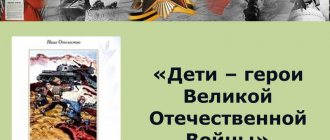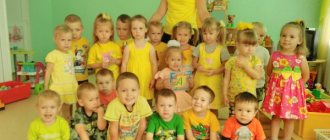4) How else do you help adults? How do your family members take care of each other?
In our family, each member has his own responsibilities.
I have them too.
I help clean the apartment, take part in family celebrations, cook dinner with my mother, take care of indoor plants - water them, trim leaves, replant them.
If someone in our family gets sick, then all family members try to help this person.
We take care of the sick person, take on his responsibilities, and visit him in the hospital.
If someone in the family needs help, then everyone is ready to help, for example, my parents often help me with my homework.
Project "My Genealogy"
— What do we know?
- What do we want to know?
- What have we learned?
(The last question is asked at the final stage of the project).
Based on the problematic situation that arose, the teachers began to develop a project.
The teachers addressed the parents with a letter, in which they expressed a request to take an active part in the project, to provide assistance in the development and implementation of the project.
(Annex 1)
Stage I.
The teachers developed a plan for the thematic project:
I. The basis for the development of the project was the origin of the topic: the initiative came from children.
II. Related activities and related concepts that can be studied during the project were identified:
Educational areas through which it is possible to implement the project:
(Appendix 2)
Stage 1 (problem formulation):
The teacher invites children to look at pictures of family members and answer questions in a playful way.
— The people closest to the child? — The youngest member of the family? The oldest family members? — Do mom and dad have siblings? How do they relate to you? What about you? - Do they have children? How do they relate to you? — How many cousins (sisters) do you have? - How are you related to grandma? - How is your mother related to your grandmother? — Do you think these are strangers or relatives? - How can you call these people in one word? — The most joyful day for every person, which happens only once a year and everyone has their own? - What is family? - Do you think it’s good to have many relatives? Why? At the first stage of the project, the problem, the purpose of the project and its main tasks, content were identified. Project participants were identified, long-term planning for working with children was developed, and a plan for interaction with parents was drawn up. Stage 2 (preparatory).
Long-term planning was developed for various areas of educational activity.
The teachers selected visual material: encyclopedias, illustrations, fiction books about the family, photos, etc. The children were given an assignment to take home: together with their parents, watch educational programs and books on the topic “My Family”, “My Genealogy. Family tree". In the group, in the process of independent activity, the pupils looked at photo albums and slides; listened to books about the family, about family and kinship relationships, looked at pictures about the family, a model of the Family Tree. Stage 3 (main).
During the work on the project, a conversation was held with the children on the topic, “My Family”;
“There is no one more dear to mom and dad in the whole world”; “My ancestry; Family tree"; “Who do you want to be like”; “Organizing everyday life in our family on weekdays”; “Family holiday - Birthday”; quiz “In which fairy tale do families meet?” The children made up a story based on the pentagram on the topic “Tell about your mother (father, grandmother, grandfather).” We memorized O. Vysotskaya’s poem “My Family.” We discussed sayings and proverbs about family with the children. There was a discussion of V. Oseeva’s stories “The Magic Word” and “Good”; reading poems by R. Gamzatov “About Grandfather”, N. Maidanik “Together with Grandmother”. During art classes, children reflected their impressions of the family in drawings and applications. The acquired knowledge was consolidated in gaming activities: through speech and didactic games. Children and parents participated in a drawing competition on the theme “My Happy Family” and to make an applique “My Genealogy. Family tree". Stage 4 (final).
At the end of our project, an exhibition of children's works was organized: drawings on the theme “My Happy Family”; applications of the family tree compiled together with the parents.
Family traditions
1) What traditions do you have in your family? When did they appear?
Our family has a wonderful tradition of always having fun celebrating the birthday of each family member.
We prepare for this holiday in advance, together we select gifts and prepare a festive treat.
Then we all get together and congratulate the hero of the day, give gifts together, have fun and have lunch.
Then we all go for a walk or to the cinema together.
This tradition dates back to the distant past, and parents love to remember how they celebrated birthdays when they were still children.
Also in our family there is a tradition of everyone going on vacation to the sea together.
This is a recent tradition and it appeared about ten years ago.
Genealogy. Family tree
Genealogy is the science of a person's family and all his family connections with other people. The word genealogy was formed from the ancient Greek words “genea” - family and “logos” - science, knowledge. Since every person comes from someone, this science is of interest to many. After all, everyone will be curious to know who their distant ancestors were.
Genealogy is a kind of knowledge of the world. By studying the history of a family, a person better understands the history of the country, learns the cultural customs and traditions of different eras.
A family tree is a short but most visual representation of family history in the form of a tree that helps to trace all family relationships. It takes a lot of effort to “grow” it. Sometimes this takes years. Sometimes it is possible to look back three, four, or even five centuries.
Since ancient times, the family tree was compiled by the eldest people in the family, and then passed on from generation to generation. The family tree was and is one of the most valuable family heirlooms in the family - nothing can be more valuable than the memory of one’s family, of those from whom we descended.
Project "Genealogical Family Tree"
Natalia Kharlamova
Project "Genealogical Family Tree"
Project in the senior group on the topic: “ Genealogical family tree ”
Type of project : group, information-research, creative.
Project duration : short-term (2 weeks)
.
Project participants : senior children, teachers, parents.
Relevance: the content of moral education of preschoolers includes solving many problems, including nurturing love for the Motherland, family , and respect for one’s parents. For a child, the family is the place of his birth and the main environment for development. It determines a lot in a child’s life. Family is a source of love, respect, solidarity and affection, something on which any civilized society is built, without which a person cannot exist. Interest in your past, your roots, knowing where you come from is in the blood of every normal person. Family history is a pedigree. Pedigree is a word about the family. Genus – all relatives who have a common ancestor. All relatives can be entered in a special table, which is called the “ genealogical table ”
, or
"
family tree " .
The goal of the project : to promote interest in one’s family , to cultivate love and respect for parents and ancestors, to form and develop personality, to develop partnerships with the family .
Project objectives :
1. To form in children an idea of family , of a moral attitude towards family traditions, to expand knowledge about their immediate environment, to teach them to understand family ties.
2. Instill in children love and respect for family , show the value of family for every person and show care for loved ones.
3. With the help of parents, create family trees of their families , promote the development of creative abilities in the process of joint activities.
Expected result:
Teachers: contact with students’ families .
Children: a feeling of love for family , children’s knowledge about their family : about family , traditions, about the life of grandparents, and their vocabulary on the topic will be enriched.
Parents: the pedagogical culture of parents will improve, trust and partnership relationships with children will be established.
Project implementation plan .
1. The first stage is preparatory
• Defining the goals and objectives of the project .
• Introducing children and parents to the purpose of the project .
• Creation of necessary conditions for the implementation of the project .
• Collecting information about the existing knowledge of children and parents about the family .
2. Second stage - project
• OOD on the topic.
• Consultations for parents “ Genealogical family tree ”
,
“How to tell a child about his roots”
,
“The whole
family is together - so the soul is in the same place .
• Creating a folder – movement “The Secret of the Name”
.
• Reading fiction on the topic.
• Conducting conversations on this topic.
•Productive activities of children together with their parents: album “My Family ”
,
“
Genealogical family tree ” 3. The third stage is the final one
Final event “Together we are one family ”
At the first stage of the project, during a survey of parents and interviews with children, it was revealed that children have insufficient knowledge about their family and family relationships, and many parents do not have an adequately developed interest in their roots. Based on the results obtained, the goals and objectives of the project , and materials for its implementation were prepared.
At the second stage of the project , consultations were offered to parents
OOD on the topic “My family ”
Conversations and looking at family photos
OOD "My Home, My Family "
»
Conversation “Tell me about your family ”
Role-playing game " Family "
Parents are active participants in the life of the group: the game “Daddy’s Helper”
Dramatization of the Russian folk tale "Turnip"
At the final stage, an exhibition of the project : “ Genealogical Family Tree ”
Final event: “Together we are one family ”
Joint visual creativity of parents and children: each participant, depicting a leaf from a tree, symbolizes only himself, and by collecting these leaves together, one big tree is obtained, as a symbol of a large family of parents , children and kindergarten.
Generalization: As a result of working on the project , children expanded their understanding of their family and their moral attitude towards family traditions. They formed an idea of the family as people living together and loving each other. We got acquainted with the concepts of clan, relatives, genealogy, family tree . The children’s creative and research abilities also developed during the project Children acquired the skills of searching and collecting information, acquired the ability to analyze and present their work. All this contributed to the development of goodwill, understanding, mutual assistance, as well as increased interest in the history of the origin of their family . Making your own family tree and family album helped children learn the history of their family , their pedigree, and formed their idea of family and family traditions. Parents have increased their competence in raising children; joint creativity has allowed them to get closer and establish trusting relationships with their children.





